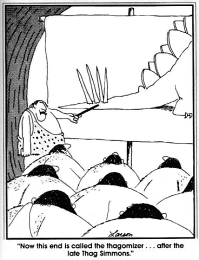Thagomizer

A thagomizer is the distinctive arrangement of four to ten spikes on the tails of stegosaurid dinosaurs. These spikes are believed to have been a defensive measure against predators.[1]
The arrangement of spikes originally had no distinct name; the term Thagomizer was coined in 1982 by cartoonist Gary Larson in his comic The Far Side, and thereafter became gradually adopted as an informal term within scientific circles, research, and education.
Paleobiology
There has been debate about whether the spikes were used simply for display, as posited by Gilmore in 1914,[2] or used as a weapon. Robert Bakker noted that it is likely that the stegosaur tail was much more flexible than those of other ornithischian dinosaurs because it lacked ossified tendons, thus lending credence to the idea of the tail as a weapon. He also observed that Stegosaurus could have maneuvered its rear easily by keeping its large hindlimbs stationary and pushing off with its very powerfully muscled but short forelimbs, allowing it to swivel deftly to deal with attack.[3] In 2010, analysis of a digitized model of Kentrosaurus aethiopicus showed that the tail could bring the thagomizer around to the sides of the dinosaur, possibly striking an attacker beside it.[4]
In 2001, a study of tail spikes by McWhinney et al.,[5] showed a high incidence of trauma-related damage. This too supports the theory that the spikes were used in combat. There is also evidence for Stegosaurus defending itself, in the form of an Allosaurus tail vertebra with a partially healed puncture wound that fits a Stegosaurus tail spike.[6] Stegosaurus stenops had four dermal spikes, each about 60–90 cm (2.0–3.0 ft) long. Discoveries of articulated stegosaur armor show that, at least in some species, these spikes protruded horizontally from the tail, not vertically as is often depicted. Initially, Marsh described S. armatus as having eight spikes in its tail, unlike S. stenops. However, recent research re-examined this and concluded this species also had four.[7][8]
Etymology

The term "thagomizer" was coined by Gary Larson in humor, in a 1982 Far Side comic, in which a group of cavemen in a faux-modern lecture hall are taught by their caveman professor that the spikes on a stegosaur's tail are so named "after the late Thag Simmons".
The term was picked up initially by Ken Carpenter, a paleontologist at the Denver Museum of Nature and Science, who used the term when describing a fossil at the Society of Vertebrate Paleontology Annual Meeting in 1993.[9] Thagomizer has since been adopted as an informal anatomical term,[10] and is used by the Smithsonian Institution,[9][11] the Dinosaur National Monument in Utah, the book The Complete Dinosaur and the BBC documentary series Planet Dinosaur.[12]
The cartoon fate of Thag Simmons notwithstanding, stegosaurs and humans did not exist in the same era; humans evolved around 60 million years after the event that killed all non-avian dinosaurs. In The Prehistory of the Far Side, Gary Larson suggests that "there should be cartoon confessionals where we could go and say things like, 'Father, I have sinned – I have drawn dinosaurs and hominids together in the same cartoon'".[13]
See also
Other scientific terms first used in comedy:
References
- ↑ Holtz, T. R., (2000) "Classification and Evolution of the Dinosaur Groups" (pp. 140–168) in The Scientific American Book of Dinosaurs, edited by Gregory S. Paul, New York: St Martin's Press ISBN 0-312-26226-4.
- ↑ Gilmore C. W. (1914). "Osteology of the armored Dinosauria in the United States National Museum, with special reference to the genus Stegosaurus". Series: Smithsonian Institution. United States National Museum. Bulletin 89. Government Printing Office, Washington (89).
- ↑ Bakker R. T. (1986). The Dinosaur Heresies. william Morrow, New York.
- ↑ Naish Darren (2010). "Heinrich's digital Kentrosaurus: the SJG stegosaur special, part II". Tetrapod Zoology. Retrieved 2011-01-19.
- ↑ McWhinney L. A., Rothschild B. M. & Carpenter K. (2001). "Posttraumatic Chronic Osteomyelitis in Stegosaurus dermal spikes". In Carpenter, Kenneth(ed). The Armored Dinosaurs. Indiana University Press. pp. 141–156. ISBN 0-253-33964-2.
- ↑ Carpenter, Kenneth; Sanders, Frank; McWhinney, Lorrie A.; Wood, Lowell (2005). "Evidence for predator-prey relationships: Examples for Allosaurus and Stegosaurus". In Carpenter, Kenneth (ed.). The Carnivorous Dinosaurs. Bloomington and Indianapolis: Indiana University Press. p. 325. ISBN 0-253-34539-1.
- ↑ Marsh O. C. (1877). "A new order of extinct Reptilia (Stegosauria) from the Jurassic of the Rocky Mountains". American Journal of Science. 3 (14): 513–514.
- ↑ Carpenter K. & Galton P. M. (2001). "Othniel Charles Marsh and the Eight-Spiked Stegosaurus". In Carpenter, Kenneth(ed). The Armored Dinosaurs. Indiana University Press. pp. 76–102. ISBN 0-253-33964-2.
- 1 2 The word: Thagomizer New Scientist 8 July 2006
- ↑ Holtz, Thomas R., Jr. (2007). Dinosaurs: the Most Complete, Up-To-Date Encyclopedia for Dinosaur Lovers of All Ages. New York: Random House. p. 230. ISBN 978-0-375-82419-7.
- ↑ "Stegosaurus Changes". Smithsonian National Museum of Natural History, Department of Paleobiology. Archived from the original on 2004-12-14. Retrieved 2007-03-03.
- ↑ Planet Dinosaur episode: "Fight for Life", about 9 minutes into episode.
- ↑ Larson, G. (1992) The Prehistory of the Far Side p. 137. Warner Books.
